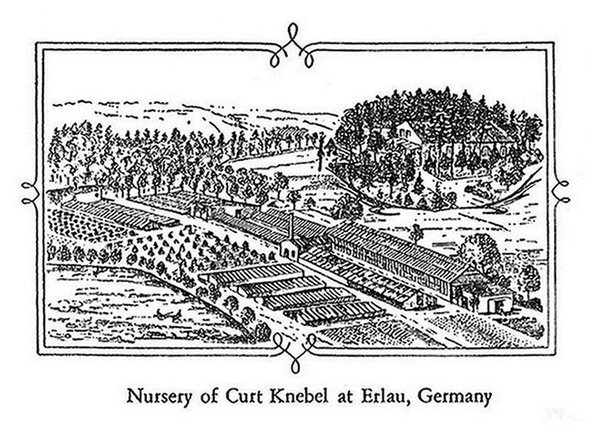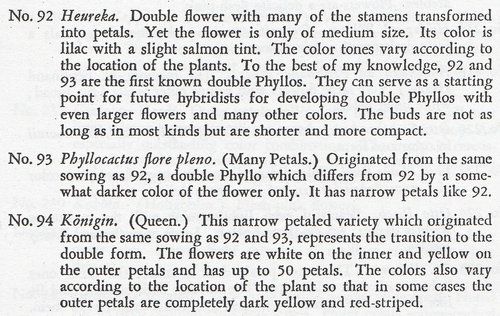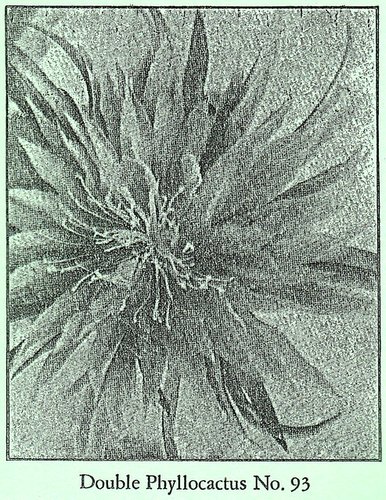** THE HYBRID EPIPHYLLUM **
*** WITH DOUBLE FLOWERS ***
____________________
CHAPTER 2 (page 4)
The hybrid Epiphyllum with double flowers of
Curt Knebel.
________________________
Page 4 / 8 of the article.
________________________________
Note: In this part the word “Phyllocactus”, used by Curt Knebel, will replace sometimes the word “Epiphyllum”, also called “Epicactus”, for a hybrid.
Curt Knebel was born on June 16th, 1871 in Erlau (Saxony).
His father was a railway employee. After having worked in the most prestigious German nurseries, in 1894 he founds his own nursery in Erlau, his home town.

Photo from the book: "Phyllocactus by Curt Knebel" ©
There, Curt Knebel continues his work about the hybridization of the Phyllocacti and in the 30s, obtains three hybrids, numbered 92, 93, 94 of which he says in his book: “Phyllocactus by Curt Knebel” published in 1949:

Photo from the book: "Phyllocactus by Curt Knebel" ©

Drawing in the inside cover of the book quoted above.
The first hybrids of Epiphyllum with double flowers have just been created.
Curt Knebel always says himself in the same book, in connection with obtaining the three hybrids above:
"This is another step forward in hybridizing, which in other days could hardly have been imagined in Phyllo cultivation, has been my success in transforming stamens to petals and thus achieving really double flower. I was the first one in Phyllo history to do this. Thus a step has been taken which will allow future generations of growers the chance to continue this work and develop it even further. The real meaning of this step will be better appreciated by everyone, when they realize that all our other double flowers such as our roses and dahlias, originated this same way."
The flowers of these three hybrids were at the beginning, modest in size, but over the years the size of these flowers increased.
One can think that Knebel hoped that it was possible, starting from his hybrids, to obtain from them other ones with larger flowers and more colors.
Knebel apparently tried to cross the two varieties 92 and 93, a first step to advance and offer seeds for these future objectives.
But it was more difficult than was envisaged (Knebel 1932) and he succeed, only afterwards many unfruitful efforts, since he mentioned a little later that he hoped that the only fruit which became ripe in spring 1934 was going to bring new forms over the years and that, perhaps in 10 years, he could publish about this (Knebel 1934).
We also know that in his catalogues Knebel offered to sell his plants and his seeds worldwide. For example, the varieties such as “Alta Scott”, “Bagdad”, “Friend Sherfy”, “Marina Special”, “Marseillaise” and several others appeared in California starting from Knebel seeds.
Thus, it is possible to think that, in a similar way, the seeds of the hybridization of the two varieties mentioned N° 92 and N° 93 - if these seeds were able to germinate - arrived to America and were sown.
One could think that it is the case of the hybrid “San Diego” obtained in the United States and registered in 1953 at the ESA with the mention: “from Curt Knebel seeds”
Thus, we can assert that, before and perhaps during World War II, some of Knebel’s material arrived in the United States. And this very much fortunately, because, under the Nazi regime, Knebel had to be reconverted by “national effort” into the cultivation of vegetables.
And we will see that Knebel’s double flowers hybrids have, most probably, played a decisive part as for the new hybrids with double flowers obtained later in the United States.
END OF CHAPTER 2.
___________________________________
BACK TO THE SUMMARY OF THE ARTICLE
_________________________________________